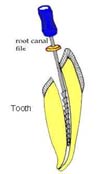 |
 |
|
|
Root canal treatment is done to save teeth which previously would have required extraction. To help you understand this procedure, we have answered some often asked questions about this treatment. |
| |
| |
| What is root canal treatment? |
| |
The pulp (Fig. 1) (nerves and blood vessels) of a tooth may die from decay, trauma or occasionally deep fillings/ restorations. If heat is applied to this tooth, the decaying pulp will expand, causing a pressure build-up that leads to the throbbing toothache. |
| |
 |
Why is root canal treatment needed?
If the pulp becomes infected, the infection may spread through the root canal system of the tooth, which may eventually lead to an abscess. If Root Canal Treatment (RCT) is not carried out, the infection will spread and the tooth may need to be taken out.
Does it hurt?
The term "root canal" conjures terrible images in most people's minds. You keep hearing the horror stories about how much they hurt, or that they didn't work, or that they are expensive. Well, think again! Yes, a few are painful and difficult, but for the most part they are the exception rather than the rule. A vast majority go from beginning to end with either no pain (sometimes no shot is needed), or with minimal pain, mostly felt after the patient leaves the office and the anesthesia has worn off. Their bad reputation is caused by the fact that the only ones that patients talk about with their friends are the difficult ones.
|
|
| |
 |
What does it involve?
First, an opening is made through the crown of the tooth. An instrument called a file (Fig. 2) is used to prepare the canals of the tooth and remove the pulp. A file resembles a needle or pin. Notice the fluting on the length of the file. This is what is used to shape or cut the inside of the canal of the tooth. The file is inserted into the tooth, and drawn back and forth, starting with the smallest file progressing to the largest, increasing the diameter of the size of the canal. Filing can be done by hand or with a machine.
Medications are put in the pulp chamber and root canal(s) to help get rid of germs and prevent infection.
|
|
| |
 |
A temporary filling will be placed in the crown opening to protect the tooth between dental visits.
The temporary filling is removed and the pulp chamber and root canal(s) are cleaned and filled with root filling points.
Once the root canal filling is complete. the opening of the tooth is sealed with a permanent filling material ( Fig. 4) which can be silver or a tooth colored restoration.
In the final step, a crown is usually placed over the tooth. |
|
| |
 |
How many sittings would it take to complete a root canal?
On an average it takes between 1 to 3 sittings to complete a root canal.
|
|
| |
| |
| Is it necessary to crown a tooth after root canal treatment? |
| |
Once the pulp of the tooth has died off or been removed, the tooth no longer has its hydrating mechanism and becomes somewhat brittle and more prone to fracture. It is important that all back teeth (molars and premolars) that have been endodonticaly treated have crowns placed on them to protect them from fracture and to restore their appearance. |
| |
| |
| Is it expensive? |
| |
The number of appointments and the intricate nature of the work, can make endodontic treatment expensive. We are glad to give an estimate of fees at a consultation appointment before commencing any treatment. |
| |
| |
| How successful is treatment? |
| |
More than 90% of cases are successful when approved techniques and materials are used. Sometimes, in spite the best intentions and the best technical skill, the tooth never really ceases to be painful or bothersome in some way. This happens in the vicinity of about 5% of the time. When this happens, either the patient lives with the results, or the tooth is finally extracted and replaced with a bridge, partial denture or an implant. |
| |
| |
| How long will the restored tooth last? |
| |
Your restored tooth could last a lifetime, if you continue to care for your teeth and gums. However, regular checkups are necessary. |
| |
| |
| Back |
|
|
|
| Site Map |
|
Site Designed & Maintained by Epigram Digital |
|



